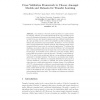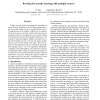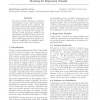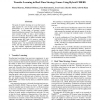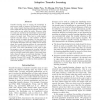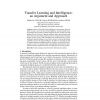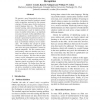PKDD
2010
Springer
14 years 24 days ago
2010
Springer
Abstract. One solution to the lack of label problem is to exploit transfer learning, whereby one acquires knowledge from source-domains to improve the learning performance in the t...
CVPR
2010
IEEE
14 years 2 months ago
2010
IEEE
Transfer learning allows leveraging the knowledge of source domains, available a priori, to help training a classifier for a target domain, where the available data is scarce. Th...
ICML
2010
IEEE
14 years 3 months ago
2010
IEEE
The goal of transfer learning is to improve the learning of a new target concept given knowledge of related source concept(s). We introduce the first boosting-based algorithms for...
ICML
2010
IEEE
14 years 3 months ago
2010
IEEE
Transfer learning can be described as the tion of abstract knowledge from one learning domain or task and the reuse of that knowledge in a related domain or task. In categorizatio...
AAAI
2006
14 years 3 months ago
2006
Related objects may look similar at low-resolutions; differences begin to emerge naturally as the resolution is increased. By learning across multiple resolutions of input, knowle...
NIPS
2007
14 years 3 months ago
2007
In transfer learning we aim to solve new problems using fewer examples using information gained from solving related problems. Transfer learning has been successful in practice, a...
IJCAI
2007
14 years 3 months ago
2007
The goal of transfer learning is to use the knowledge acquired in a set of source tasks to improve performance in a related but previously unseen target task. In this paper, we pr...
AAAI
2010
14 years 3 months ago
2010
Transfer learning aims at reusing the knowledge in some source tasks to improve the learning of a target task. Many transfer learning methods assume that the source tasks and the ...
AGI
2008
14 years 3 months ago
2008
In order to claim fully general intelligence in an autonomous agent, the ability to learn is one of the most central capabilities. Classical machine learning techniques have had ma...
ACL
2008
14 years 3 months ago
2008
We present a novel hierarchical prior structure for supervised transfer learning in named entity recognition, motivated by the common structure of feature spaces for this task acr...
